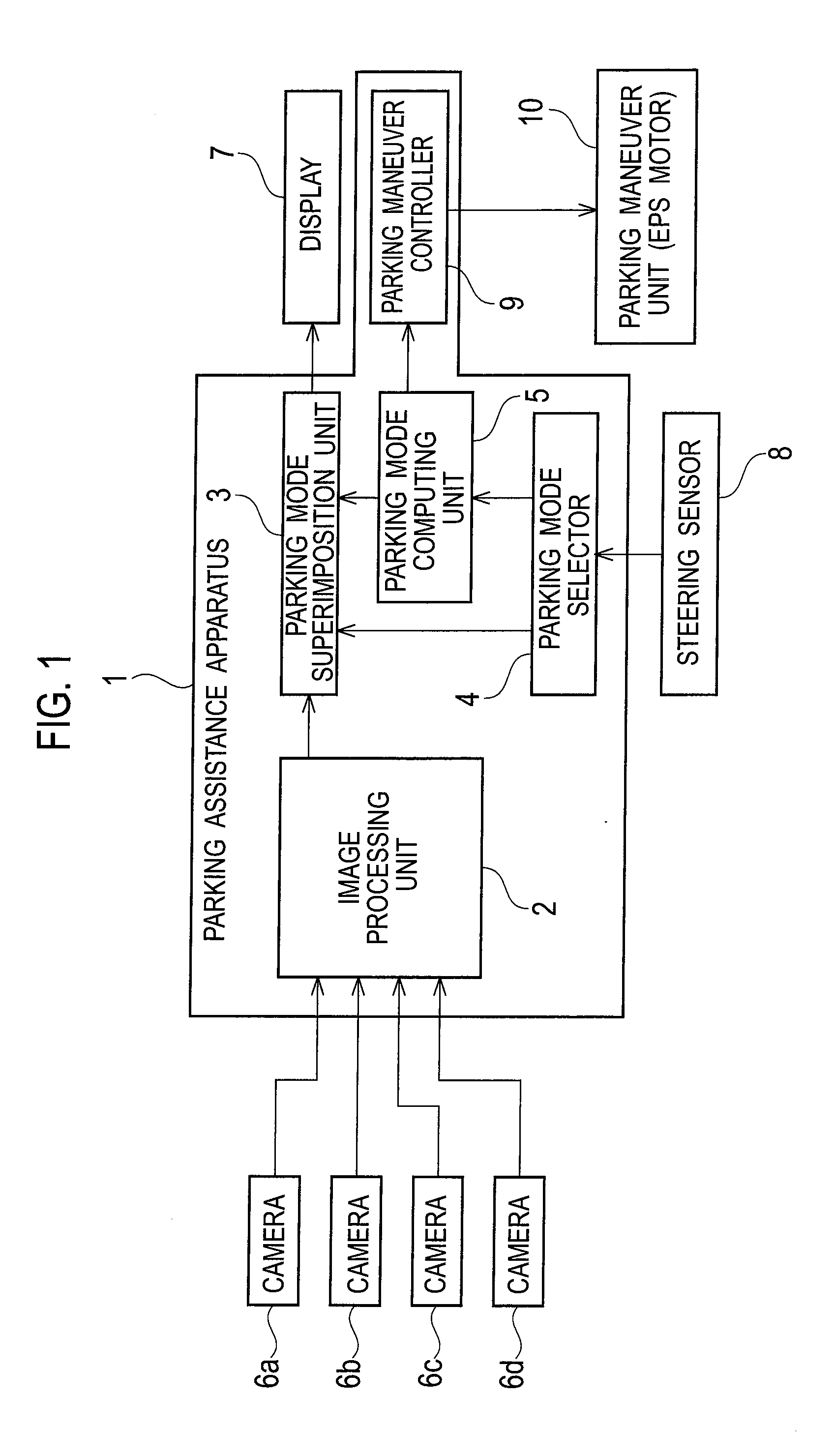Parking mode selection apparatus and method
a technology of selection apparatus and parking mode, applied in the direction of steering initiation, vessel parts, instruments, etc., to achieve the effect of improving operability and easy setting
- Summary
- Abstract
- Description
- Claims
- Application Information
AI Technical Summary
Benefits of technology
Problems solved by technology
Method used
Image
Examples
first embodiment
[0040][Configuration of Parking Mode Selection Apparatus]
[0041]A first embodiment will be explained with reference to FIGS. 1 to 10.
[0042]As shown in FIG. 1, the parking mode selection apparatus 1 includes an image processing unit 2, a parking mode superimposition unit 3, a parking mode selector (also served as a operation detector) 4, a parking mode computing unit 5, and a parking maneuver unit controller 9. The image processing unit 2 transforms movies of an environment of a vehicle to generate a top view movie. The parking mode superimposition unit 3 superimposes an image that indicates a parking mode on the top view movie of an environment of a vehicle. The parking mode selector 4 selects a parking target position and a parking mode based on a driver's steering operation. The parking mode computing unit 5 computes a parking route to the parking target position. In addition, the parking mode selection apparatus 1 is connected also with cameras 6a to 6d, a display 7, steering sens...
second embodiment
[0081]Next, a second embodiment will be explained with reference to FIGS. 11 to 14. Note that configurations identical or similar to those in the above-explained first embodiment are labeled with identical numerals, and their detailed explanations are omitted.
[0082][Configuration of Parking Assistance Apparatus]
[0083]As shown in FIG. 11, a parking assistance apparatus 111 according to the present embodiment further includes a torque computing unit 112 that computes torque for returning a steering wheel to the neutral position.
[0084]In a case where a steering wheel is returned to the neutral position after road wheels have been steered by rotating the steering wheel from a stop state, a steering system may move by it self due to residual distortion energy of tires when leaving hands from the steering wheel, so that the steering wheel may rotate by itself. If a steer angle θ comes out of a parking mode setting range (−α112 computes a torque value for returning the steering wheel to th...
third embodiment
[0103]Next, a third embodiment will be explained with reference to FIGS. 15 and 16. Note that configurations identical or similar to those in the above-explained first and second embodiments are labeled with identical numerals, and their detailed explanations are omitted.
[0104]In the present embodiment, as shown in FIG. 15, a torque toward the neutral position (reactive torque T4) is applied only when the steer angle θ is within the parking mode setting range (−αα) in the vicinity of the neutral position. On the other hand, the EPS system is controlled in a normal mode when the steer angle θ is outside the parking mode setting range (−αα).
[0105]For example, as shown in FIG. 15, a counter-clockwise torque (a reactive torque having a plus value) is applied in the range −αα. A driver can get a moderate reactive feel by this torque, so that the steer angle θ can become held at the neutral position (θ=0°). In addition, the above-explained rotation of the steering wheel caused by the resi...
PUM
 Login to View More
Login to View More Abstract
Description
Claims
Application Information
 Login to View More
Login to View More - R&D
- Intellectual Property
- Life Sciences
- Materials
- Tech Scout
- Unparalleled Data Quality
- Higher Quality Content
- 60% Fewer Hallucinations
Browse by: Latest US Patents, China's latest patents, Technical Efficacy Thesaurus, Application Domain, Technology Topic, Popular Technical Reports.
© 2025 PatSnap. All rights reserved.Legal|Privacy policy|Modern Slavery Act Transparency Statement|Sitemap|About US| Contact US: help@patsnap.com



